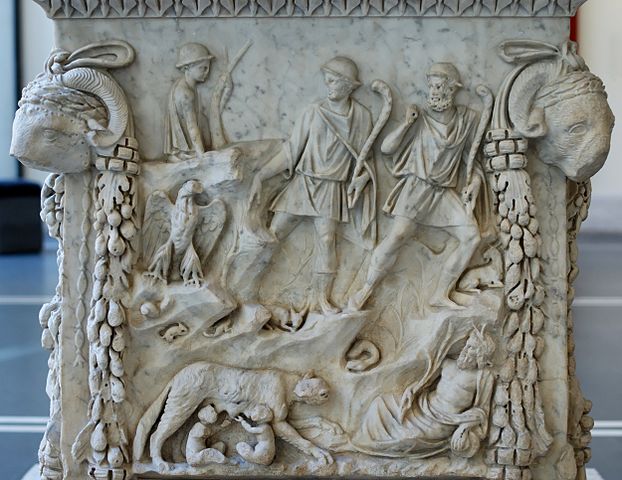TWH – Mardi Gras, with its pageantry and Bacchanalian celebrations, feels like it should have a Pagan origin. While some Pagans have argued that it does, another source exists for this belief. Evangelic Protestants have “accused” Catholics of tolerating Pagan elements for about 600 years. They argue that residual Pagan practice has corrupted the Catholic Church.
While some use the terms “Mardi Gras” and “Carnival” interchangeably, they have different meanings. The former refers to a single day, the latter to a season.

[Public domain]
Mardi Gras refers to the Tuesday before Ash Wednesday. It ends at midnight on Tuesday, as Lent begins. For people unfamiliar with Lent, it lasts from Ash Wednesday through Easter Sunday. It is considered a time for penitence, abstinence, and reflection. Catholics frequently give up something up for Lent, usually a small vice like candy, alcohol, or social media. Among Catholics, Mardi Gras is the last day of indulgence before Lenten abstinence – something like a bachelor party before a wedding – hence the name, which is French for “Fat Tuesday.”
Carnival, on the other hand, refers to entire the pre-Lenten season. Its beginning dates vary with region. In the New Orleans/Louisiana tradition, it begins with the Feast of the Epiphany/Dia de los Tres Reyes on January 6, the day the Three Wise Men (Tres Reyes or the Persian Magi) presented gifts to Jesus. Carnival also ends at midnight on Mardi Gras. The word “carnival” may derive from the Latin “carne vale” or “farewell to meat,” refering to the Lenten custom of abstaining from eating meat.
Proposed pagan sources for Mardi Gras
People have proposed several pagan sources for Mardi Gras. Two that stand out are Saturnalia and the Lupercalia.

“Representation of Lupercal” From the portico of the Piazzale dei Corporazioni in Ostia, Antica. (98-117 CE) [public domain].
Saturnalia, a feast of Saturn, occurred between December 12 and December 23. It involved public banquets, private gift-giving, gambling, and lots of partying. Many of the customs of Saturnalia re-appear in contemporary Christmas celebrations.
Lupercalia occurs in mid-February. That festival involved the sacrifice of a goat. After that sacrifice, young men would run through the city naked or nearly so. They would strike people with thongs of bloody flesh from that sacrificed goat. People celebrated this at least until 500 CE. Geoffrey Chaucer, the famed English poet who died in 1400, linked the Lupercalia to St. Valentine’s day.
Problems with these holidays evolving into Mardi Gras
Saturnalia has many obvious links with Christmas. It is close in time, public banquets, gift exchange, and lots of partying. It has much fewer elements in common with Mardi Gras. It also occurs roughly two months before Mardi Gras.
The main custom of the Lupercalia involves running through the streets naked or semi-naked. During this run, the young men would strike people with thongs of bloody goat meat. This has few parallels with Mardi Gras. It does have some loose similarities with one custom, namely the throwing of beads to crowd, especially in response to playful sexual displays, such as “flashing” parts of one’s body that are normally taboo to display publicly. Status accrues to people with many beads by the end of Mardi Gras.
From 500 through 800 CE, Christian elites attacked “pagan” practices thought to drive out winter. Details on what these practices looked like at the time, and how they might have varied by region, are scarce due to a lack of surviving sources. These practices occurred all over Europe. They might represent survival of Germanic, Slavic, or Celtic traditions, not Italic ones. The Christian authorities could have labeled any secular hedonistic festivities as “pagan practices.”
The earliest known record of any pre-Lenten holiday occurred in Rome. Between 1140 CE and 1143 CE on the Sunday before Ash Wednesday. The Pope took part in the procession. Three animals were sacrificed. A bear represented the Christian devil. A young bull represented pride in pleasure. A rooster represented lechery of the loins.
Weak evidence exists for Lupercalia or Saturnalia to have evolved into Mardi Gras. This does not mean evolution would be impossible, just that the evidence is weak. Consistent recorded evidence from late antiquity through the Middle Ages is missing.
And yet – Mardi Gras still feels pagan, doesn’t it?
The carnivalesque archetype
There may not be evidence of Mardi Gras as a direct descendent of ancient paganism, but the season still participates in a sensual and expressive mode of celebration that certainly resembles some forms of modern Paganism. We might, for lack of a better term, call it a kind of Jungian archetype.

Bicyclists on parade in the Heart of the Beast May Day Parade [S. Fox.]
We can compare Mardi Gras to celebrations like the Heart of the Beast May Day Parade or Pride celebrations, events which share in much of the same ethos as Fat Tuesday. Indeed, we might call all of these celebrations “carnivalesque.”
Mardi Gras has parades, floats, costumes, alcohol and drug use, and lots of exposed flesh. It is indulgent and hedonistic. If it feels Pagan, it might be because it’s Dionysian, a celebration of the senses and the body. Is it a holdover from the ancient ways? Probably not – but it’s no surprise that so many modern Pagans are drawn to this ostensibly Catholic holiday.
The Wild Hunt is not responsible for links to external content.
To join a conversation on this post:
Visit our The Wild Hunt subreddit! Point your favorite browser to https://www.reddit.com/r/The_Wild_Hunt_News/, then click “JOIN”. Make sure to click the bell, too, to be notified of new articles posted to our subreddit.